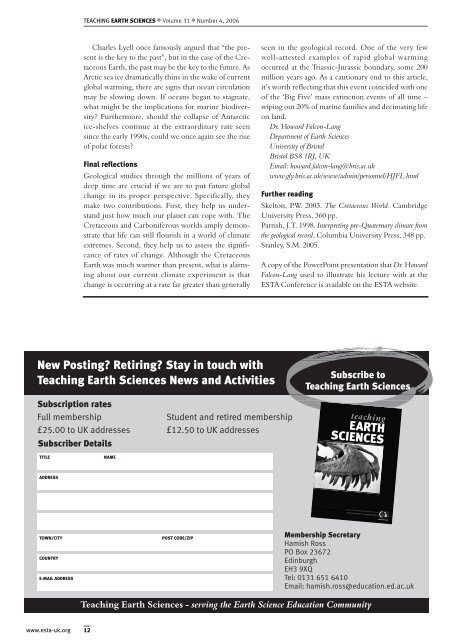teaching - Earth Science Teachers' Association
teaching - Earth Science Teachers' Association
teaching - Earth Science Teachers' Association
Create successful ePaper yourself
Turn your PDF publications into a flip-book with our unique Google optimized e-Paper software.
Magazine of the EARTH SCIENCE TEACHERS’ ASSOCIATION<br />
Volume 30 ● Number 3, 2005 ● ISSN 0957-8005<br />
www.esta-uk.org<br />
TEACHING EARTH SCIENCES ● Volume 31 ● Number 4, 2006<br />
Charles Lyell once famously argued that “the present<br />
is the key to the past”, but in the case of the Cretaceous<br />
<strong>Earth</strong>, the past may be the key to the future. As<br />
Arctic sea ice dramatically thins in the wake of current<br />
global warming, there are signs that ocean circulation<br />
may be slowing down. If oceans began to stagnate,<br />
what might be the implications for marine biodiversity?<br />
Furthermore, should the collapse of Antarctic<br />
ice-shelves continue at the extraordinary rate seen<br />
since the early 1990s, could we once again see the rise<br />
of polar forests?<br />
Final reflections<br />
Geological studies through the millions of years of<br />
deep time are crucial if we are to put future global<br />
change in its proper perspective. Specifically, they<br />
make two contributions. First, they help us understand<br />
just how much our planet can cope with. The<br />
Cretaceous and Carboniferous worlds amply demonstrate<br />
that life can still flourish in a world of climate<br />
extremes. Second, they help us to assess the significance<br />
of rates of change. Although the Cretaceous<br />
<strong>Earth</strong> was much warmer than present, what is alarming<br />
about our current climate experiment is that<br />
change is occurring at a rate far greater than generally<br />
seen in the geological record. One of the very few<br />
well-attested examples of rapid global warming<br />
occurred at the Triassic-Jurassic boundary, some 200<br />
million years ago. As a cautionary end to this article,<br />
it’s worth reflecting that this event coincided with one<br />
of the ‘Big Five’ mass extinction events of all time –<br />
wiping out 20% of marine families and decimating life<br />
on land.<br />
Dr. Howard Falcon-Lang<br />
Department of <strong>Earth</strong> <strong>Science</strong>s<br />
University of Bristol<br />
Bristol BS8 1RJ, UK<br />
Email: howard.falcon-lang@bris.ac.uk<br />
www.gly.bris.ac.uk/www/admin/personnel/HJFL.html<br />
Further reading<br />
Skelton, P.W. 2003. The Cretaceous World. Cambridge<br />
University Press, 360 pp.<br />
Parrish, J.T. 1998. Interpreting pre-Quaternary climate from<br />
the geological record, Columbia University Press, 348 pp.<br />
Stanley, S.M. 2005.<br />
A copy of the PowerPoint presentation that Dr. Howard<br />
Falcon-Lang used to illustrate his lecture with at the<br />
ESTA Conference is available on the ESTA website.<br />
New Posting? Retiring? Stay in touch with<br />
Teaching <strong>Earth</strong> <strong>Science</strong>s News and Activities<br />
Subscription rates<br />
Full membership<br />
Student and retired membership<br />
£25.00 to UK addresses £12.50 to UK addresses<br />
Subscriber Details<br />
Subscribe to<br />
Teaching <strong>Earth</strong> <strong>Science</strong>s<br />
<strong>teaching</strong><br />
EARTH<br />
SCIENCES<br />
TITLE<br />
NAME<br />
ADDRESS<br />
TOWN/CITY<br />
COUNTRY<br />
E-MAIL ADDRESS<br />
POST CODE/ZIP<br />
Membership Secretary<br />
Hamish Ross<br />
PO Box 23672<br />
Edinburgh<br />
EH3 9XQ<br />
Tel: 0131 651 6410<br />
Email: hamish.ross@education.ed.ac.uk<br />
Teaching <strong>Earth</strong> <strong>Science</strong>s - serving the <strong>Earth</strong> <strong>Science</strong> Education Community<br />
www.esta-uk.org<br />
12

















